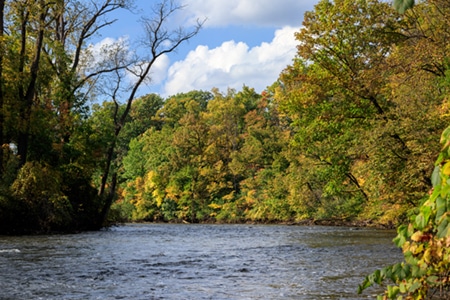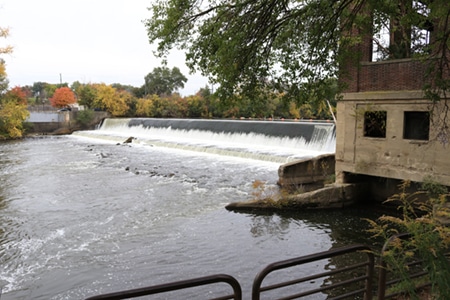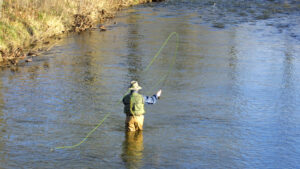
Many dams in the U.S. have been an important part of infrastructure, serving to help with flood control and water supply, generating power, and by creating recreational opportunities. Most dams are quite old and no longer serve their original purpose, and in recent decades, our understanding of how dams affect rivers’ health has improved. Dams commonly disrupt natural river flow processes and sediment transport. They block passage for aquatic organisms, create a reservoir where there was a natural, free flowing river, and increase water temperatures. This better understanding gives us new perspective in evaluating aging dams that no longer serve their original purpose and require expensive repairs to maintain public safety. Even dams that are not in immediate need of repair can be public safety hazards, with drownings a high risk.
A comprehensive review of the short- and long-term ecological impacts of dam removals in the U.S. was conducted by the group American Rivers in 2002. The authors concluded that although limited short-term consequences may exist, the long-term ecological benefits of dam removals are clear. These benefits include improvements in water quality, reconnecting habitat, restoring natural sediment transport, and helping native species recover.
Good Grades Matter
Michigan has approximately 2600 dams that were constructed for many reasons. As in most states, dams were often constructed in faster moving river sections with greater elevation change (called high gradient sections). This creates a problem for aquatic life because these high gradient stretches also benefit a variety of species. High gradient stretches of river provide excellent habitat with pool-riffle sequences to support the various life stages and needs of many species. Unfortunately, due to the topography of Michigan, these higher gradients are rare and are the most likely to have been dammed. This is the case in the Huron River watershed. The mainstem of the Huron River has 19 dams, some of which were initially constructed for hydropower. The highest gradient stretch of river runs from Ann Arbor to Belleville and is now a series of nearly back-to-back impoundments formed by dams built or rebuilt between 1914 – 1932.
What does this mean for Ypsilanti’s Peninsular Paper Dam?

In the Huron River, only 6 miles (4%) of the mainstem has this most desirable high gradient, (dropping in elevation at a rate between 10 and 69.9 feet per mile) and 2.4 of those 6 miles are blocked by dams, making it unavailable to fish as river habitat. Peninsular Paper Dam (Pen Dam) in Ypsilanti sits on one of the highest gradient areas on the mainstem. In the 1.25 miles from the dam upstream to end of the human-made pond, called an impoundment, the slope of the natural river bottom averages 10 feet/mile. This is much higher than the 2.95 feet/mile average gradient of the mainstem. Removal of Pen Dam would eliminate a slow-moving shallow reservoir that warms water temperatures and would return 52% of this valuable high gradient, diverse river habitat to its natural free flowing state for aquatic organisms. This would also provide diverse paddle sport opportunities as opposed to the flat, slow-moving reservoir.
Peninsular Paper Dam is over 100 years old and has not generated power in over 50 years. To meet state safety standards, significant repairs would have to be made by the City of Ypsilanti, which is the current dam owner. Partly due to their significant liability and risks as dam owners, the Ypsilanti City Council passed a resolution to pursue dam removal in 2019.
The Michigan Department of Natural Resources (DNR), Fisheries Division is highly supportive of the removal of Pen Dam on the Huron River for several reasons. Although this project would be on a relatively small scale compared to some dam removals, the habitat and gradient that would then be available to fish in this part of the Huron River is of much higher quality than in many dam removal situations. Access to this habitat and increased connectivity would also benefit several threatened and endangered freshwater mussel species that inhabit the Huron River.
Multiple personnel with DNR-Fisheries have been involved in the Pen Dam Restoration Committee to provide expertise in planning for a successful removal and restoration of the river, impounded area, and parkland. When dam removal occurs, DNR will work closely with the engineers and contractors to make sure sediment transport is handled properly. We are assisting with identifying and applying for funding to aid in this effort.
Improved Connectivity
Removing Pen Dam would increase river connectivity, provide high quality fish and freshwater mussel habitat, would return 1.25 miles of impoundment to natural stream conditions, and reconnect over 3 miles of river. The habitat in this stretch of the Huron is rare in the watershed and very valuable to a range of fish species and macroinvertebrates. indicate fish and macroinvertebrate community health in the Ypsilanti stretch of river is excellent and organisms would greatly benefit from an extension of this stretch of open river.
Removal of Pen Dam would almost double the length of river that fish coming upstream from Ford Lake would have access to for spawning, as well as an important nursery area for juvenile fish. Ford Lake has the only self-sustaining population of walleye in inland waters of southeast Michigan because they can spawn in the small stretch of rocky, high velocity habitat just below Pen Dam. Ford Lake is a very popular fishing destination with high catch rates. Increasing the stretch of river available for spawning would increase the successful reproduction of walleye and other species such as smallmouth bass and white bass, benefitting anglers in both the Huron River and Ford Lake.
The removal of Pen Dam would also open the door to future increased connectivity in the Huron River with potential installation of fish ladders or other dam removals.

Recreational Benefits
Game fish species, such as smallmouth bass, walleye, and white bass would benefit greatly from the increased access to prime spawning habitat, nursery areas and likely cooler water temperatures that would result from Pen Dam removal. This could increase opportunity for fishing at public areas along this stretch of river as well as in Ford Lake, which had the third highest open water fishing effort per acre in a survey of 20 lakes during 2000-2006. Given the increased open stretch and uncovered riffles, this would also likely be a very popular destination for paddle sport enthusiasts.
The river bottom in the Huron River between Pen Dam and the start of Ford Lake is made up primarily of gravel and cobble, along with boulders. Once the river returns to its natural state, this rocky river bottom will likely be the most common habitat in the former impoundment area as well, a type of habitat particularly good for fish, mussels, and insect health.

Community and Safety Benefits
The Michigan Dam Safety Task Force reports that 80 dams have been removed in Michigan thus far. When Pen Dam is successfully removed, it is expected that the public would benefit as well. There would be more parkland and fishing access at Peninsular Park with fewer safety concerns. Although the techniques required for fishing the former impoundment area may have to adjust to take advantage of the free-flowing section and species may shift slightly, the fishing is still expected to be excellent. We’re excited to see this vital river restoration move forward for the benefit of both the nearby communities and wildlife.
– Sara Thomas, Michigan Department of Natural Resources, Fisheries Division Lake Erie Unit Manager
 |
Sara Thomas is the Lake Erie Unit Manager for the Michigan Department of Natural Resources Fisheries Division. Prior to that, she was an Aquatic Ecologist for the Lake Michigan Biological Station with the Illinois Natural History Survey for 14 years. She was recently elected vice president of the North Central Division of the American Fisheries Society. She holds a Master’s degree in Aquatic Ecology from the University of Michigan and a bachelor’s degree in Water Resources and Environmental Biology from Heidelberg University. |



